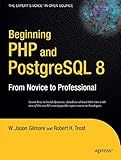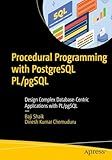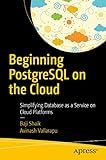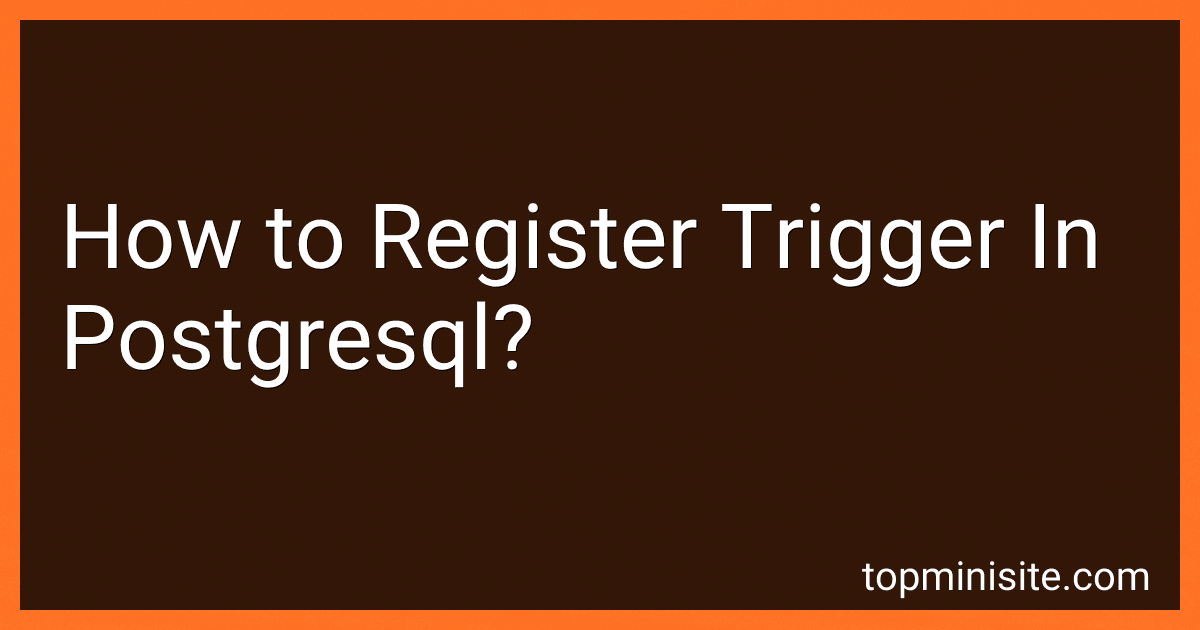Best PostgreSQL Trigger Tools to Buy in December 2025

PostgreSQL: A Practical Guide for Developers and Data Professionals



Full-Stack Web Development with TypeScript 5: Craft modern full-stack projects with Bun, PostgreSQL, Svelte, TypeScript, and OpenAI



Beginning PHP and PostgreSQL 8: From Novice to Professional (Beginning: From Novice to Professional)
- AFFORDABLE PRICING COMPARED TO NEW BOOKS!
- ECO-FRIENDLY CHOICE: REDUCE WASTE WITH USED BOOKS!
- QUALITY ASSURANCE: OUR 'GOOD CONDITION' GUARANTEE!



Procedural Programming with PostgreSQL PL/pgSQL: Design Complex Database-Centric Applications with PL/pgSQL



SQL Hacks: Tips & Tools for Digging Into Your Data
- QUALITY ASSURANCE: GENTLY USED BOOKS WITH MINIMAL WEAR.
- AFFORDABLE PRICES: SAVE ON COSTS WITHOUT SACRIFICING QUALITY.
- SUSTAINABLE CHOICE: ECO-FRIENDLY OPTION BY REUSING BOOKS.



PostgreSQL for Python Web Development with Flask: A Practical Guide to Building Database-Driven Web Applications



Beginning PostgreSQL on the Cloud: Simplifying Database as a Service on Cloud Platforms



Building Modern Business Applications: Reactive Cloud Architecture for Java, Spring, and PostgreSQL


In PostgreSQL, you can register a trigger function with the CREATE TRIGGER command. When creating a trigger, you specify the trigger name, the table it operates on, the event that triggers the function (e.g., INSERT, UPDATE, DELETE), and the function that will be called when the trigger fires.
To register a trigger in PostgreSQL, you can use the following syntax:
CREATE TRIGGER trigger_name BEFORE INSERT OR UPDATE OR DELETE ON table_name FOR EACH ROW EXECUTE FUNCTION trigger_function();
In this example, replace the trigger_name with the name you want to give to your trigger, table_name with the name of the table you want to create the trigger on, and trigger_function() with the name of the function you want to call when the trigger fires.
Once you have created the trigger, it will automatically be activated whenever the specified event occurs on the specified table. You can also use the DROP TRIGGER command to remove the trigger if necessary.
How to register a trigger to log changes in a table in PostgreSQL?
To register a trigger to log changes in a table in PostgreSQL, you can follow these steps:
- Create a trigger function that will be executed whenever a specified operation (INSERT, UPDATE, DELETE) occurs on the table you want to monitor. This function will be responsible for logging the changes.
CREATE OR REPLACE FUNCTION log_changes_func() RETURNS TRIGGER AS $$ BEGIN -- Log the changes here IF (TG_OP = 'INSERT') THEN INSERT INTO audit_table VALUES (NEW.id, 'INSERT', NOW()); ELSIF (TG_OP = 'UPDATE') THEN INSERT INTO audit_table VALUES (NEW.id, 'UPDATE', NOW()); ELSIF (TG_OP = 'DELETE') THEN INSERT INTO audit_table VALUES (OLD.id, 'DELETE', NOW()); END IF;
RETURN NEW; END; $$ LANGUAGE plpgsql;
- Create a trigger on the table you want to monitor that will call the trigger function you just created.
CREATE TRIGGER log_changes_trigger AFTER INSERT OR UPDATE OR DELETE ON your_table FOR EACH ROW EXECUTE FUNCTION log_changes_func();
- You can now test the trigger by performing INSERT, UPDATE, or DELETE operations on the table. The changes will be logged in the audit_table.
Note: Make sure to replace audit_table with the actual name of the table where you want to log the changes, and replace your_table with the name of the table you want to monitor. Also, ensure that the trigger function and trigger itself are created with appropriate permissions.
What is the limitation on the number of triggers that can be registered in PostgreSQL?
In PostgreSQL, there is no specific limitation on the number of triggers that can be registered on a single table or database. However, it is important to keep in mind that having a large number of triggers on a table can impact performance and manageability. It is recommended to only use triggers when necessary and to avoid creating an excessive amount of them.
How to disable a trigger in PostgreSQL?
To disable a trigger in PostgreSQL, you can use the DISABLE TRIGGER command. Here's how you can do it:
- Connect to your PostgreSQL database using a client tool like psql or pgAdmin.
- Identify the name of the trigger that you want to disable. You can use the following query to list all triggers in the database:
SELECT trigger_name FROM information_schema.triggers WHERE trigger_schema = 'public'; -- or specify the schema name where the trigger is located
- Once you have identified the trigger you want to disable, use the following command to disable it:
DISABLE TRIGGER trigger_name ON table_name; -- Replace trigger_name with the actual name of the trigger and table_name with the name of the table where the trigger is defined
- Verify that the trigger has been disabled by using the \d+ command in psql or by checking the trigger status in pgAdmin.
- To re-enable the trigger, you can use the ENABLE TRIGGER command:
ENABLE TRIGGER trigger_name ON table_name;
That's it! You have successfully disabled and re-enabled a trigger in PostgreSQL.
How to register a trigger to enforce data integrity in PostgreSQL?
You can register a trigger in PostgreSQL to enforce data integrity by following these steps:
- Define the trigger function: Create a PL/pgSQL function that will contain the logic you want to enforce. This function will be executed when the trigger is activated.
- Create the trigger: Use the CREATE TRIGGER statement to define the trigger and associate it with the table and event(s) you want to monitor.
- Attach the trigger function to the trigger: Use the ON statement within the trigger definition to associate the trigger function with the trigger event.
- Test the trigger: Insert, update, or delete data in the table to see if the trigger function is enforced.
Here is an example of creating a trigger to enforce data integrity in PostgreSQL:
- Define the trigger function:
CREATE OR REPLACE FUNCTION check_data_integrity() RETURNS TRIGGER AS $$ BEGIN -- Add your logic here to enforce data integrity IF NEW.column_name < 0 THEN RAISE EXCEPTION 'Value cannot be negative'; END IF; RETURN NEW; END; $$ LANGUAGE plpgsql;
- Create the trigger:
CREATE TRIGGER enforce_data_integrity BEFORE INSERT OR UPDATE ON your_table FOR EACH ROW EXECUTE FUNCTION check_data_integrity();
- Test the trigger: Now, when you insert or update data in your_table, the trigger function check_data_integrity() will be executed to ensure that the data meets the integrity constraints you have defined.
How to create a trigger in PostgreSQL?
To create a trigger in PostgreSQL, follow these steps:
- First, connect to the database using a database management tool or command line interface.
- Use the following syntax to create a trigger:
CREATE TRIGGER trigger_name BEFORE INSERT OR UPDATE OR DELETE ON table_name FOR EACH ROW EXECUTE FUNCTION function_name();
Replace trigger_name with the desired name for the trigger, table_name with the name of the table on which the trigger should be applied, and function_name() with the name of the function that should be executed when the trigger is fired.
- Customize the trigger according to your requirements. You can set the trigger to fire before or after an INSERT, UPDATE, or DELETE operation on the table. You can also specify if the trigger should fire for each row affected by the operation.
- Once you have customized the trigger, execute the query to create it. The trigger will now be created and applied to the specified table in the database.
- To view the list of triggers in a database, you can use the following query:
SELECT trigger_name, event_object_table FROM information_schema.triggers WHERE trigger_schema = 'public';
That's it! You have successfully created a trigger in PostgreSQL. Make sure to test the trigger thoroughly to ensure it behaves as expected.
How to register multiple triggers in PostgreSQL?
In PostgreSQL, you can register multiple triggers on a table by using the CREATE TRIGGER command multiple times. Each trigger has a unique name and can be defined for different events (e.g. INSERT, UPDATE, DELETE) and timing (e.g. BEFORE, AFTER).
Here is an example of how to register multiple triggers on a table:
-- Create a trigger that fires before an insert operation CREATE TRIGGER trigger_name1 BEFORE INSERT ON table_name FOR EACH ROW EXECUTE FUNCTION trigger_function1();
-- Create a trigger that fires after an update operation CREATE TRIGGER trigger_name2 AFTER UPDATE ON table_name FOR EACH ROW EXECUTE FUNCTION trigger_function2();
In the above example, trigger_name1 and trigger_name2 are the names of the triggers, table_name is the name of the table on which the triggers are being registered, trigger_function1 and trigger_function2 are the names of the functions that will be called when the triggers fire.
You can register as many triggers as needed on a table by using the CREATE TRIGGER command with different names, events, and functions. Each trigger will be executed in the order they were created.
